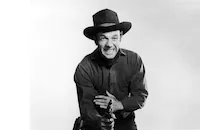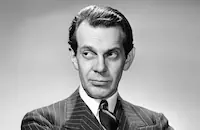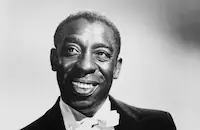God Is My Co-Pilot

Brief Synopsis
Cast & Crew
Robert Florey
Dennis Morgan
Dane Clark
Raymond Massey
Alan Hale
Andrea King
Film Details
Technical Specs

Synopsis
In Kunming, China, in 1942, pilot Robert L. Scott watches Major General Claire L. Chennault with envy as he briefs a squadron of pilots for an air strike on Japan. The grounded Scott is upset that he will not be able to participate in an action for which he has prepared from the time he was a small boy living on a farm near Macon, Georgia: As a teenager, Scottie buys an old World War I airplane, then in 1932, he graduates from West Point. Later, Scottie qualifies as a pilot at Kelly Field in Texas. After his marriage to Catherine, Scottie trains to be a combat pilot, but when war is declared, is forced to become an instructor, because at thirty-four he is too old to fight. One day, Scottie is ordered to Wright Field in Florida. After additional training, Scottie and his crew fly a B-17 bomber plane under sealed orders to India, where they then wait for further orders. Eventually, the crew learns that they were to bomb Tokyo from a base in the Philippines, but because the Japanese have since occupied the islands, the mission has been canceled. Instead, the crew is assigned to ferry supplies to the Flying Tigers, mercenaries under the leadership of Chennault, who have contracted to fight on behalf of the Chinese government. After Scottie witnesses the Tigers' aggressive response to a Japanese attack, he entreats Chennault to teach him the Tigers' combat techniques. Chennault agrees to loan Scottie a battered airplane to repair and train in. Later, during a solo encounter with the Japanese, Scottie is so effective that the Japanese mistake him for an entire squadron. The killing takes its toll on Scottie, however, and he tries to resolve his feelings during talks with Catholic priest "Big Mike" Harrigan. When the Flying Tigers' contract with the Chinese elapses, Chennault is made a brigadier-general in the U.S. Army Air Force. Goaded by the Japanese, the retiring Flying Tigers decide to stay on until the new Air Force pilots are ready to take over. After the squadron carries out a bombing raid on Hong Kong, which is occupied by the Japanese, Scottie is reported dead. Scottie is alive, but when he returns to the base, he is worn out from malaria attacks and combat fatigue. Although the doctor grounds him, Scottie prays that he be allowed to fly one last mission, and just as the squadron takes off for Tokyo, Chennault sends Scottie with them.

Director

Robert Florey
Cast

Dennis Morgan

Dane Clark

Raymond Massey

Alan Hale

Andrea King

John Ridgely

Stanley Ridges

Craig Stevens

Warren Douglas

Stephen Richards
Charles Smith

Minor Watson

Richard Loo
Murray Alper
Bernie Sell
Joel Allen
John Miles
Paul Brooks

Clarence Muse
William Forrest
Frank Tang
Philip Ahn
Dan Dowling
Buddy Burroughs
George Cleveland

Ghislaine Perreau

Don Mcguire
William Challee
Joel Friedkin
Frank Jacquet
Lou Mason

James Flavin
Richard Wang
Eddie Lee
Leon Lontoc
Luke Chan
Doris Chan
Bo Ling
Bo Ching
Frances Chan
Elena Beattie
Joy Darwin
Bonnie Campana
Matia Antar
Susanne Ramos
Barbara Gill
Mari Jinishian
Paul Fung
Sanders Clark
Phyllis Adair
Wing Foo
Harold Fong
Clarence Lung
Sammee Tong
Barbara Jean Wong
Jean Wong
Chet Voravan
Bob Chinn
Jack Santos
Weaver Levy
Angel Cruz
Albert Law
George Chung
Paul King
Fred Fisher
Charles Hayes
Steve Keyes
Nick Kirk
Ralph Mccolm
Russell Platt
Henry Vroom
Lionel Sells
Warren Cross
Randy O'hara
Dale Van Sickel
Tom Steele
Robert Strong
Art Foster
Joe Marievsky
Emilio Alegata
James Linn
Sigmundo A. Martinez
Leo Abbey
Carlos Garrido
Frank Ho Wong
Don Escobar
Percy Incion
Crew
Folmer Blangsted
Robert Buckner
Robert Burks
Roy Davidson
Gordon M. Davis
Paul Detlefsen
Edwin Du Par
Abem Finkel
Leo F. Forbstein
Charles David Forrest
Jack Gage
Oliver S. Garretson
Hetta George
Lester Guthrie
Sid Hickox
John Hughes
Michael Joyce
Herman Lissauer
Charles Marshall
E. Kenneth Martin
Jack Mcconaghy
Peter Milne
Leonid Raab
Leah Rhodes
Col. Robert Lee Scott Jr.
Jack L. Warner
Franz Waxman
Perc Westmore

Photo Collections
Videos
Movie Clip




Trailer
Hosted Intro
Film Details
Technical Specs

Articles
God Is My Co-Pilot - God is My Co-Pilot
Based on the memoirs of Colonel Scott, God Is My Co-Pilot (1945) chronicles the story of the Flying Tigers, with a special emphasis on the spiritual conflicts that go along with the life of a fighter pilot in wartime. Scott (Dennis Morgan) is stricken with guilt after strafing a Japanese column and seeing men fall dead beneath his plane's bullets. For solace, he turns to the priest, Mike Harrigan (Hale), who benevolently gives Scott a special prayer for pilots. Eventually, Scott's faith is put to the test when his plane is shot down and he's stranded behind enemy lines.
Though critics of the time gave God Is My Co-Pilot lukewarm reviews, calling it mawkish and pedestrian, the film proved to be a hit with audiences. Indeed, it was the number-one film among GIs between the years l942 and l945, possibly because they understood the psychological and spiritual anguish of the film's characters. Raymond Massey, as General Chennault, had served (and been injured) in both World Wars with the Canadian army. Also, the U.S. military cooperated with the film's production, supplying P-40Fs and crews for the aerial segments and volunteering Luke AFB in Arizona for a filming location.
Director Robert Florey was a very talented "old school" Hollywood director, having moved up the ranks as art director and assistant director since the l920s. His use of an elaborately choreographed dance segment (shot from overhead) in l929's The Cocoanuts predated Busby Berkeley's musical numbers by several years. He was originally slated to direct the 193l version of Frankenstein before being replaced by James Whale. Florey's stylish work on the Lugosi vehicle Murders in the Rue Morgue (1932) led many to wonder what the future of horror movies may have been like had he been allowed to direct Frankenstein> as well. Though he was assigned many B-movies and TV shows during his career, Florey also wrote several books on film theory and criticism and was eventually awarded a knighthood in France's Legion d'Honneur for his contributions to film.
Producer: Robert Buckner
Director: Robert Florey
Screenplay: Abem Finkel, Peter Milne
Art Direction: Stanley Fleischer, John Hughes
Cinematography: Sidney Hickox
Costume Design: Leah Rhodes
Film Editing: Folmar Blangsted
Original Music: Franz Waxman
Principal Cast: Dennis Morgan (Col. Robert L. Scott), Dane Clark (Johnny Petach), Raymond Massey (Maj. Gen. Chennault), Alan Hale ("Big Mike" Harrigan), Andrea King (Catherine Scott), John Ridgeley (Tex Hill), Craig Stevens (Ed Rector), Mark Stevens (Sgt. Baldridge).
BW-88m. Closed captioning.
By Jerry Renshaw

God Is My Co-Pilot - God is My Co-Pilot
Quotes
Trivia
Notes
As depicted in the film, Colonel Robert Lee Scott, Jr. was determined to fly airplanes, even as a child. In 1921, he bought a WWI "Jenny" at public auction and took flying lessons from a former WWI pilot. Despite his bad academic record, Scott graduated from West Point in 1932, after taking remedial classes. He married his girl friend after a whirlwind courtship and in 1934 became an Army airmail pilot. After war was declared in 1941, Scott applied for combat duty, but was rejected because of his age. He continued to pursue a combat assignment, however, and eventually, after lying about his experience with the Flying Fortress, was given command of one of thirteen bombers assigned to bomb Japan. The proposed bombing was canceled because, in the meantime, the Japanese had taken all American bases in the Philippines. Scott remained in the Far East as a pilot ferrying men, refugees, and supplies along the China-Assam route. Later he convinced General Claire Chennault to give him a P-40 and became an effective combat pilot. Unlike in the film, Scott was never shot down, although his plane was often shot at and he, himself, was wounded. In January 1943, Scott was ordered back to the United States to train fighter pilots.
According to a May 4, 1944 Hollywood Reporter news item, Cary Grant and Humphrey Bogart were both announced as the star of this film. A press release notes that this was at one time to be a Hal B. Wallis production. According to memos included in the records of the War Department, Wallis wanted Colonel Robert L. Scott to play himself in the film, and if that were not possible, wanted Scott to contribute to the script, as he believed the pilot's contribution would make the screenplay more effective. The Army Air Force denied this request, as they believed it would interfere with Scott's military duties. By February 1, 1944, however, Scott was made available for temporary duty as a technical advisor. Other War Department records add that despite objections to an early screenplay, expressed in a September 30, 1943 memo from Colonel William Westlake, assistant to the Director for Army Air Forces, to Allyn Butterfield, Chief of the Feature Film Section of the War Department Bureau of Public Relations, a revised screenplay met with Air Force approval, and by October 1943, War Department cooperation was granted. Macon, GA, the site of the film's world premiere, was Robert Lee Scott's hometown. According to a March 22, 1945 letter from Brig. Gen. Ray L. Owens to Pain, Lowe & Coffin, Esqs. contained in the holdings at NARS, Lieut. Patrick D. Holland was killed during aerial maneuvers that comprised part of his military training and the flight was photographed by the film's cameramen and included in God Is My Co-Pilot. Some scenes were shot on location at Metropolitan Airport in Van Nuys, CA.

Miscellaneous Notes
Released in United States Spring April 7, 1945
Released in United States Spring April 7, 1945















